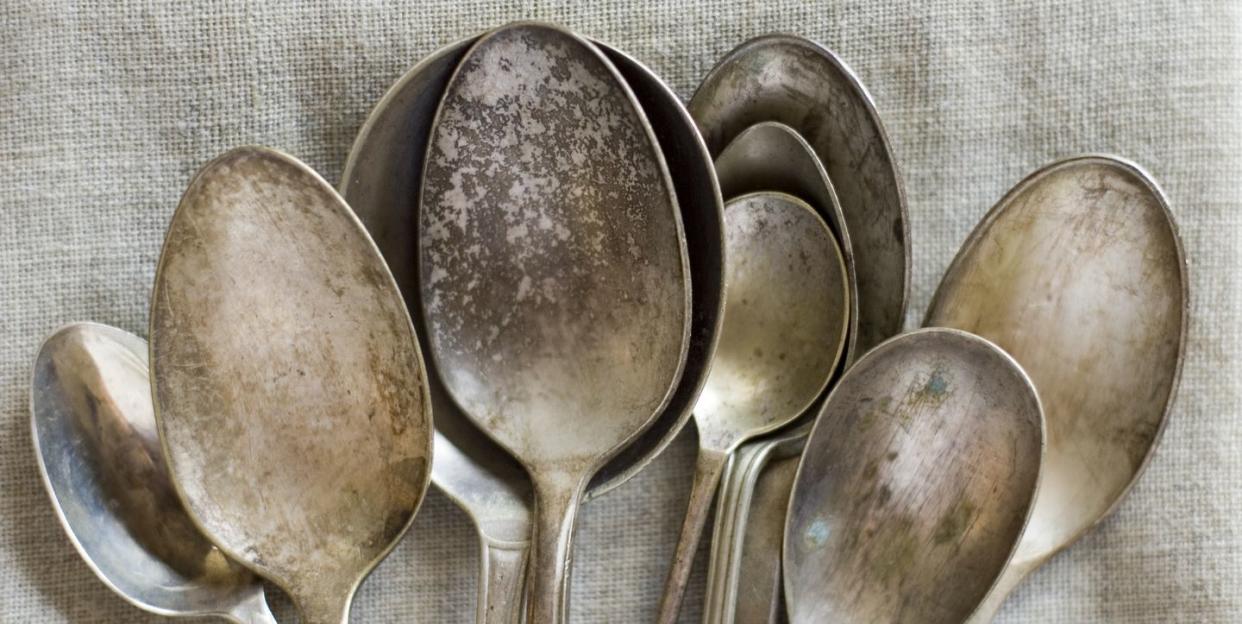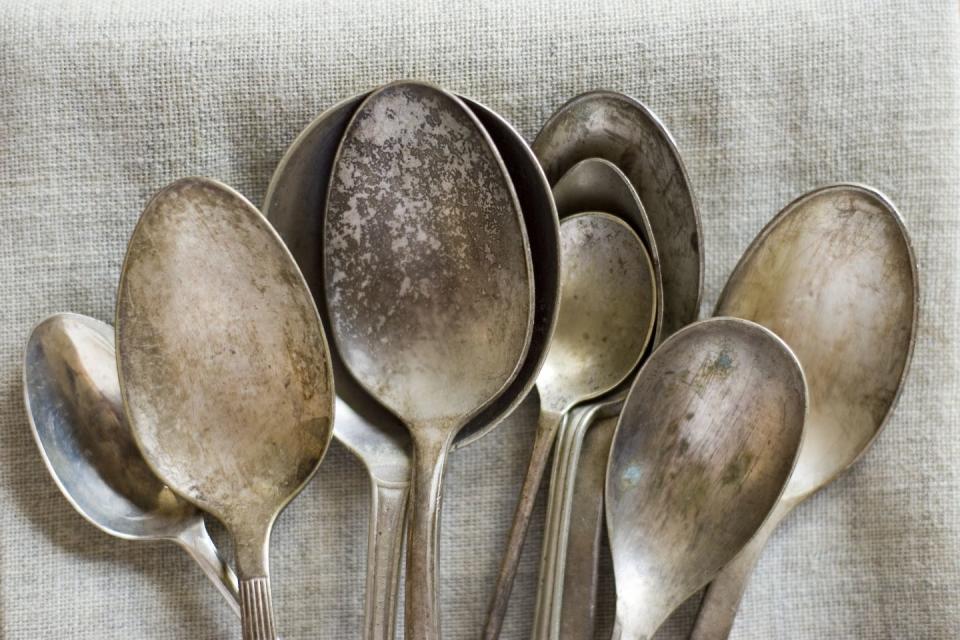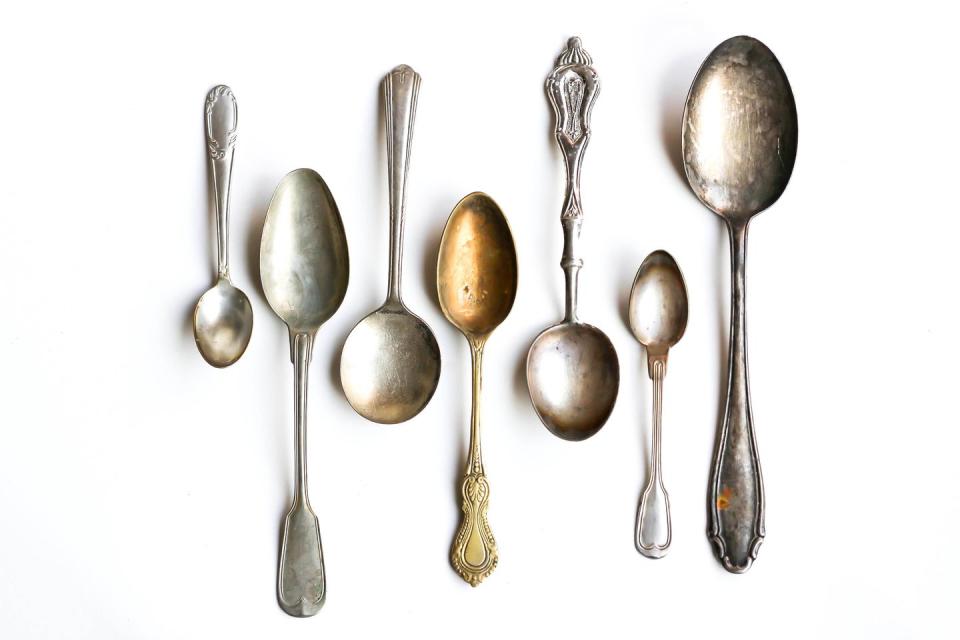How to Clean Silver and Make All of Your Heirlooms Sparkle

"Hearst Magazines and Yahoo may earn commission or revenue on some items through the links below."
Few metals make such beautiful heirlooms as silver, including jewelry, cutlery sets, candlesticks, and serving platters. If you've had any of these precious items passed down to you, then it's likely you handle them with care knowing that your family has maintained them for years. Perhaps it's the silverware set your mother always used when she taught you how to set a table or maybe you finally bought your own candlesticks to the Christmas mantle, knowing you can give them to your children one day.
Whatever the case, you'll eventually find that your silver pieces lose their luster over time. The beautiful shine gives way to a heavy tarnish; you know the look: a dull, splotchy metallic color. While silver can last far longer than other commonly used household items like dinnerware sets or roasting pans, it does require upkeep to look its best. The good news is you can easily polish silver right at home with a few easy-to-find products!

Now, you might have seen methods that use everyday pantry items, like ketchup, toothpaste, or baking soda. According to Jeffrey Herman, the founder of American Silversmiths, all of these home solutions are much too abrasive and do more damage in the long run. "It's like sandpaper," Herman says. "Ketchup, toothpaste, et cetera, are too acidic and will ruin the silver. The same goes for the aluminum foil technique."
These quick cleaning techniques will dull your silver, or they will remove the applied patina in the crevasses of the object. While you may have seen grandma do this with great luck, the result was probably misleading. "Some of these changes can happen over time," he explains, "so you won't notice it at first."
Read on to find out the one exception to Herman's rule, plus how to clean silver at home and return your silverware to tip-top shape.
Why does silver tarnish?
Silver tarnish is a natural response to the elements. It's a chemical reaction when silver is exposed to sulfur gasses, according to the Canadian Conservation Institute. This causes it to darken and form a layer of tarnish, and the color changes with exposure to light. In the case of tableware, regular handling with bare skin deposits oils, salt, and acids on the metal and can also be corrosive over time. With silver jewelry, however, you don't have to worry about this as much since regular friction with wear keeps the pieces bright.
How often should you polish silver?
Polishing and cleaning silver are two different tasks, and you can over-polish silver. In a routine cleaning, you can simply wash it in warm water with a gentle soap (non-scented, phosphate-free) to keep it shiny. Dry with a soft cloth or air dry, and store in a cool place with low humidity. Silver that is cleaned this way won't require frequent polishing.
Polishing is necessary, but it is naturally corrosive. You should only need to polish your pieces two to six times a year, according to Herman, and you can tell that tarnish has started to form because a light yellowish tint appears on the surface.
What you need to polish silver with commercial products:
Silver polish or cleanser
Microfiber cleaning cloth, cotton cloth, cotton balls, or cellulose sponges
Clean nitrate or cotton gloves
Clean cotton towel
How to clean tarnished silver with commercial products:
One of the simplest routes for polishing silver is using a gentle commercial silver polish—you can refer to Herman's Silver Polish Abrasion Ratings for his favorite products. "It's always best to spend more time polishing with a mild polish than less time with an abrasive one," Herman notes, "and never use a polish that says it's for all metals."

He prefers cleaning with cotton balls or swabs because they work faster than a sponge. Always polish your silver on a surface covered with a cotton towel. Follow the product instructions, or these steps:
Place a small amount of polish on your cloth, ball, or sponge.
Focusing on one area at a time, gently rub the polish against the silver in a straight back-and-forth motion. With large objects, work from the outer edges inward.
As the cloth or sponge becomes discolored, turn it to ensure you're not redepositing the tarnish. You can always get a new cloth if it's too heavily soiled. Similarly, if you're using cotton balls or swabs, don't be stingy about throwing them away and grabbing a new one.
Once the tarnish is removed, rinse with warm water and buff dry completely with a clean cotton cloth.
If the silver will come in contact with food, wash it with soap and water after polishing.
How to clean tarnished silver with hand sanitizer:
Herman says you can remove light tarnish using one "handy" household item: hand sanitizer! This everyday product is a good first mode of attack before resorting to silver polish. "Hand sanitizer will remove some minor polish and grime, though it will leave a little residue," he says.
Sanitizer is a helpful fix if you're in a pinch during the holidays, and it won't destroy your pieces. Here's how to clean with hand sanitizer:
Apply a small amount of alcohol-based sanitizer to a cotton ball or swab.
Work the cotton in a back-and-forth motion. Turn as it discolors with the tarnish.
Rinse with warm water or use a moistened cotton towel to remove the residue and dry completely.
If water doesn't work, use dish soap or glass cleaner.
How to store silver and prevent tarnish:
The American Institute for Conservation of Historic Works notes that noble metals such as silver corrode less readily than baser metals like iron. However, you can still be proactive about their care by keeping them free of dust or surface grime. Here are some tips for storing silver and preventing discoloration:
Store in a cool place with low humidity.
If you are storing after polishing, use gloves when you handle the pieces to prevent the oils on your hands from transferring to the pieces.
Store silver jewelry or flatware in silver storage bags or sulfur-absorbing flannel bags, which drastically decreases the rate of tarnish. You can place these in polyethylene bags (such as a Ziploc bag) and remove air before closing.
Place a piece of chalk into an anti-tarnish bag to absorb moisture.
Avoid placing loose silver in wooden drawers or containers, as the wood can emit corrosive gasses.
Remove silver jewelry when cleaning the house with corrosive chemicals or when spraying perfume (this prevents the perfume from landing on your silver).
You Might Also Like

